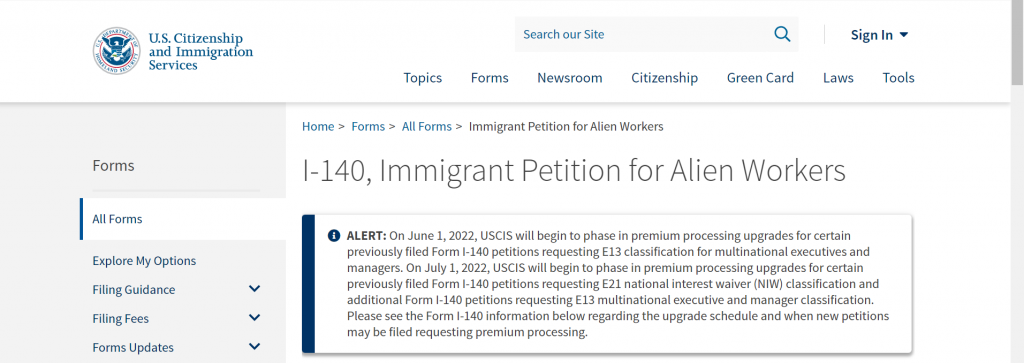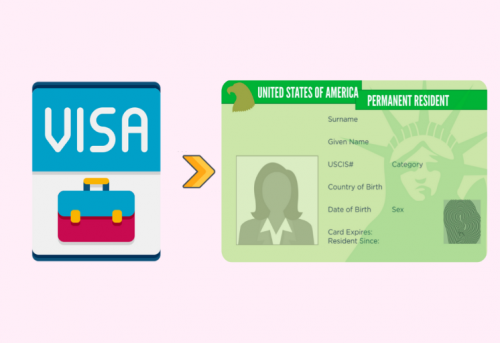Are you a foreign national (nonimmigrant) who came to the United States of America on an L1 Visa and is now loving your life here? Do you feel smitten by the endless freedom and opportunities that this land has to offer and wish to live through them past your visa limits by becoming an immigrant? Do you wish to have a peaceful life in the USA without worrying about visa renewals and their restrictions? If your answer to all of the above questions is a BIG Yes! Then, here is a comprehensive guide that will help you sail through the process of adjustment of status from L1 visa to green card, and you may successfully acquire permanent residency.
However, before we dive into the process of transition from an L1 Visa to green card, let’s first understand the premises of all the related aspects and parameters like what is an L1 visa, Why you should switch from an L1 Visa to a Green Card, who may be eligible to apply for the Green Card, the various categories and their requirements. So, Are you ready to learn all about the transition and more? Let’s walk through the entire process step by step, shall we?
Table of Contents
A Quick Recap (L1 Visa)
The L1 visa is a nonimmigrant visa that allows foreign nationals of multinational companies to enter the United States in order to work in a managerial or executive position or perform specialized knowledge work.
To qualify for an L1 visa, the foreign national must have been employed with the company abroad for at least one year out of the last three years. Additionally, the foreign national must be coming to the United States to work for a US-based subsidiary, parent company, or affiliate of the foreign employer.
The L1 visa allows foreign nationals to live and work in the United States for up to seven years. After that time, the foreign nationals must return to their home country for at least one year before they are eligible to apply for another L1 visa. Spouses and children of L1 visa holders may also enter the United States on an L2 visa and are allowed to attend school and/or work while in the country.
There are two types of L1 visas:
– L1A visa for managers and executives
– L1B visa for employees with specialized knowledge
To apply for an L1 visa, the foreign national’s employer must file a petition with the US Citizenship and Immigration Services (USCIS). Once the petition is approved, the foreign national can then apply for a visa at a US consulate or embassy abroad.
If you are a foreign national of a multinational company looking to work in the United States, the L1 visa may be right for you initially. But, over the years, as you get comfortable living in America and wish to gain the status of permanent residency, you will have to go through a process, “Adjustment of Status,” to switch from an L1 visa to green card.
How To Transit from L1 Visa To Green Card?
You cannot switch directly from an L1A Visa to a Green Card. Transiting from the L1A Visa to a Green card requires you to file a petition for the “Adjustment of status” first. “Adjustment of status” allows you to apply for permanent residency without having to return to your home country. Adjustment of status depends upon your category of employment, which varies from EB-1 to EB 3. Therefore, in order to transit from an L1A Visa to a Green card, you will have to route visa EB1C, EB2C, or an EB-3C category. Let’s understand how.
L-1 A Visa To Green Card via EB-1C
The transition from an L1A visa to a green card can be a bit complicated. However, it is possible to do so by first applying for permanent residence status. Once you have obtained your permanent residence status, you can then apply for a green card. Through this article, we aim to make the journey of transition simple and smooth for you by providing all the relevant information needed to plan and process the L1 A Visa to Green Card fluently and effectively.
Requirements for EB-1C
As an executive or manager of a multinational company, you will be filing for an employment Green Card under the EB1C category. To be considered for this category, you must;
- Have been employed as a manager or in any executive capacity in a company or organization outside the United States.
- You should have worked for at least a year in the three years prior to filing the petition.
- You came over to the US on a transfer within the same company or organization, or as an affiliate or subsidiary, in a managerial or executive capacity.
- Your US employer has been doing business for at least one year as an affiliate, a subsidiary, in the same company or organization that employed you abroad.
- There should be a qualifying relationship like common ownership or control between the U.S. and overseas companies/organizations.
Please note: To transit from the L1 visa to Green Card through the EB1C category PERM Labor Certification is not required.
Once you have the requirement sorted, it’s only obvious to think of the next step, which is the application procedure.
Application Process
The Application process is rather straight and clear, as mostly, there are only two sets of forms that you have to submit:
- An immigrant petition
- Green Card application.
Immigration Petition
To get the EB1C visa, your employer must sign Form I-140, a petition for the nonimmigrant Worker. According to the procedure, you must have an approved immigrant petition before filing Form I-485.
Green Card Application
Form I-485 is your claim to seek an adjustment of status and permanent residency. Upon receiving your Form I-485, USICS will call you to register your biometrics, including your fingerprints, photo, and signature. This information will be used for verifying your identity and conducting mandatory background checks for security reasons. This will also affirm whether you need an interview for adjustment of status or not. After that, you will be summoned to the USCIS office primarily to verify the copy of the documents submitted by you; it is advisable to carry your passport or any other official travel documents along when going to USCIS.
Later on, you can expect a notice from USCIS indicating their decision on your application. If it’s a yes for you, you will receive a green card shortly after receiving the notice. However, if your application stands denied, the notice will contain the reasons for the same. You may try getting the green card once again by filing a motion for reconsideration.
L-1B Visa To Green Card via EB-2C
The L-1B visa is a nonimmigrant visa that allows foreign national employees of international companies with US branches to live and work in the United States. This type of visa is also known as an intracompany transfer visa. Candidates who are eligible for a Green Card through an L1B visa usually fall under the following categories;
1. EB2 category (advanced degree)
2. EB2 category (skilled or professional worker).
Requirements for EB-2C
Before submitting the immigration petition, your employer must have an approved labor certification from the US Department of Labor (DOL). The DOL labor certification affirms two things,
- There is a shortage of availability of qualified and willing U.S. workers to fill the requirement at the prevailing wage.
- Hiring a foreign national will not adversely affect the wages and working conditions of their U.S counterparts.
Application procedure
To initiate the process of transition, your sponsoring employer must get hands-on PERM Labor Certification. Essentially, this requires the employer to confirm you will be paid the prevailing wage rate and affirm that no US citizen or US permanent residents are available to fulfill the work requirement.
Later on, your sponsor will raise an I-140 petition for you, depending upon when your priority date is becoming current. USCIS will consider your priority date as the date of reception of your petition. This would require you to keep an eye on US visa bulletins to know when the priority date has become current. Accordingly, you may proceed and submit Form I-485.
This entire process usually takes about 8 months which includes 30 days of job order requirement, followed by 30 days of the waiting period and 6 months of processing time for the ETA-9089 application. However, premium processing of Form I-140 is available on some charges; it helps in scaling down the processing time from six months to 15 days.
L-1B Visa To Green Card via EB-3C
The third category(EB 3) is applicable to all skilled workers, professionals, and other workers. Skilled workers are those who have a minimum of 2 years of training or work experience. A professional is the one whose job requires him/her to have at least a U.S. Bachelor’s degree or foreign equivalent. An unskilled worker is someone who performs unskilled labor requiring less than 2 years of training or experience.
Requirements for EB-3C
Skilled Workers
- You must be able to prove at least two years of job experience or training, which is not of a temporary or seasonal nature.
- Befitting post-secondary education can be considered as training.
- You must be able to perform work for which qualified workers are not available in the USA.
- Labor certification and a permanent, full-time job are also among the essential requirements.
Professionals
- You must establish that you have earned a U.S. bachelor’s degree (or its foreign equivalent) related to the current occupational needs.
- You must undertake the work for which qualified workers are not available in the United States.
- A permanent, full-time job offer and a Labour certification are required.
Unskilled Workers (Other Workers)
- You must be able to do unskilled labor.
- Less than two years of training or experience is acceptable under this category.
- Labor certification and a permanent, full-time job would be required.
Application Procedure
Your employer must:
- Get Form I-140.
- Approved Application for Permanent Labor Certification (DOL) from the U.S. Department of Labor
- Complete and sign Form I-140
- Pay the filing fee (if applicable)
- Provide all supporting documentation/evidence.
Additionally, your employer must be able to stand the ability to pay the offered wage as of your visa priority date.
Individuals from all three categories must provide evidence of labor certification and a copy of the job offer, and these also must be accompanied by an approved individual labor certification from the Department of Labor (Form ETA-9089).
Gather the required documentation you will need to provide evidence of your qualifications, such as degrees or work experience. To file an I-140 petition, you will need to provide evidence that you are eligible for immigrant status. This includes a copy of your passport, birth certificate, and employment offer letter.

If you are submitting any documents in a foreign language, you must attach a full English translation, along with a certification from the translator stating that the translation is complete and accurate and that they are authorized and competent to translate from the foreign language to English.
Benefits of Transiting from LI Visa to the Green Card
There are several benefits of having a Green Card. Some of the imminent benefits include:
-The ability to stay and work permanently in the United States
-The ability to travel freely in and out of the United States
-The ability to apply for US citizenship (after meeting certain requirements)
-The ability to sponsor family members for US permanent residence
-The ability to receive certain government benefits, such as Social Security and Medicare
Challenges of transiting from L1 visa to Green Card and how to overcome them?
The L1 visa is a nonimmigrant visa that allows foreign workers to come to the United States to work for their employers. The L1 visa holder may be eligible for a green card, granting them permanent residence status in the United States. However, some challenges may arise during the transition from an L1 visa to a green card.
- One challenge is that the L1 visa holder may not have a job offer from their employer in the United States. To be eligible for a green card, the L1 visa holder must have a job offer from a U.S. employer. Without a job offer, the L1 visa holder will not be able to adjust their status to permanent residence.
- Another challenge is that the L1 visa holder may not have the required skills or qualifications for the job they are offered in the United States. To be eligible for a green card, the L1 visa holder must have the necessary skills and qualifications for the position. If the L1 visa holder does not have the required skills or qualifications, they may be denied a green card.
- The last challenge is that the L1 visa holder may not meet the required income level for the position they are offered in the United States. To be eligible for a green card, the L1 visa holder must meet the required income level for the position. If the L1 visa holder does not meet the required income level, they may be denied a green card.
One effective way to overcome these challenges is to consult an immigration lawyer. An immigration lawyer can help the L1 visa holder navigate through the process correctly.
L1 Visa to Green Card Cost
The cost may vary because there are various ways to get a green card on an L1 visa. Here is a general breakdown of L1A to EB1 green card.
Adjustment of Status
- I-485 fee: $750-$1,140
- I-140 filing fee: $700
- Biometrics fee: $85, If applicable
Consular Processing
- I-140 filing fee: $700
- DS-260 immigrant application fee: $230
- Affidavit of Support fee: $88, If applicable
- Biometrics fee: $85, If applicable
L1B visa to Green Card Cost
- PERM cost: free
- I-140 filing fee: $700
- I-485 filing fee: $750-$1,140
- DS-260 fee: $230, If applicable
- Affidavit of Support fee: $88, If applicable
- Biometrics fee: $85, If applicable
- Premium processing fee (optional): $1,440
Processing time from an L-1 visa to the Green Card
In most cases, the processing time to transit from an L-1A visa to the Green Card can stretch up to 12 months. Transit from L-1B to a Green card can take more than 18 months, depending on when the priority date is becoming current. For L-1B visa holders, the PERM Labor Certification stage may take about 8 months. However, if your sponsor is subject to supervised recruitment or an audit, the process may take up to two years.
Form I-140 can take 6 months to process; this also depends upon the caseload and service status of the center that is processing the petition; meanwhile, you may continue to wait for your priority date to become current. It usually takes between 8 to 15 months for the I-485 form to process, and it takes additional 6 months for the Green Card to be issued to you.
Please note: For the EB2 category, this waiting period may stretch from a few months to a couple of years.
Conclusion
Despite the challenges that may arise during the transition from an L1 visa to a Green Card, there are ways to overcome them. Irrespective of the category you may belong to, the transition from L1 Visa to a Green Card is a lengthy process and would require you to be patient. Having all your documents in place and following the mentioned guidelines will keep you from avoidable delays and denials.
Frequently Asked Questions
Can an L1 visa holder apply for a green card?
Yes. An L1 visa holder can apply for a green card, granting them permanent residence status in the United States.
How long does it take from an L1 visa to a green card?
The process of transition from an L1 visa to a green card can take 12-18 Months. It is important to consult with an experienced immigration attorney to ensure that the process goes smoothly and to avoid any delays.
Can the L1B to green card process be shortened?
Yes, you can opt for premium processing ($ 1440) to fasten the process of your case.
Is an L1 visa to a green card without an employer possible?
Yes, it’s possible. You have to self-petition through visa categories: National Interest Waiver (EB-2) and Extraordinary Ability (EB-1) to get your green card.

















